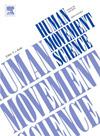Two sources of performance-stabilizing synergies: An experimental exploration using finger force production
IF 1.9
3区 心理学
Q4 NEUROSCIENCES
引用次数: 0
Abstract
We explored the hypothesis on two sources of finger force variance in multi-finger accurate force production tasks, related to variability in the sharing of total force among finger forces and to sensory-based covariation of the finger forces. This hypothesis was explored within the space that did not affect task-specific performance variable (the uncontrolled manifold, UCM) and within the space that affected this variable (orthogonal to the UCM, ORT). Young, healthy subjects performed steady-state accurate total force production tasks with and without targets for the individual finger forces. These targets varied in size from 1.5% to 40% of the task total force level. The UCM hypothesis framework was used to quantify the two variance components, VUCM and VORT, across trials and across 0.1-s samples selected from single 30-s trials at 1-s intervals. Across all conditions, VORT was similar for the inter-trial and single-trial analyses and across the finger force target sizes. In contrast, VUCM (typically larger than VORT) was smaller during the single-trial analyses compared to the inter-trial analyses. VUCM also decreased significantly with the drop in the target size for individual finger forces. We interpret these results as pointing at two sources of VUCM. First, variability in the sharing of total force between the individual finger forces, based on practice, that can be seen from the very beginning of trials. Second, negative covariation of finger forces along individual trials based on visual feedback and, potentially, on loops within the central nervous system. Combining single-trial and inter-trial analyses of variance can provide information on these two sources and turn into a tool to quantify impaired control of movement stability in neurological patients.
性能稳定协同效应的两个来源:使用手指力生产的实验探索
我们探讨了多指准确力产生任务中手指力变化的两个来源的假设,这两个来源与手指力之间总力共享的变异性和手指力基于感官的协变有关。这个假设是在不影响特定任务绩效变量的空间(不受控制的流形,UCM)和影响该变量的空间(与UCM正交,ORT)中探索的。年轻、健康的受试者在有或没有单个手指力目标的情况下执行稳态准确的总力产生任务。这些目标的规模从占任务总兵力的1.5%到40%不等。使用UCM假设框架来量化两个方差成分,VUCM和VORT,跨试验和0.1 s样本,从单个30 s试验中选择1-s间隔。在所有情况下,试验间和单试验分析以及手指力目标大小的VORT相似。相比之下,与试验间分析相比,单试验分析中的VUCM(通常大于VORT)更小。VUCM也随着单个手指力量的目标尺寸的下降而显著下降。我们将这些结果解释为指向VUCM的两个来源。首先,基于练习,单个手指力量之间的总力量分担的可变性,从一开始就可以看出。第二,基于视觉反馈和中枢神经系统回路的单个试验中手指力的负共变。结合单试验和试验间方差分析可以提供这两个来源的信息,并成为量化神经系统患者运动稳定性控制受损的工具。
本文章由计算机程序翻译,如有差异,请以英文原文为准。
求助全文
约1分钟内获得全文
求助全文
来源期刊

Human Movement Science
医学-神经科学
CiteScore
3.80
自引率
4.80%
发文量
89
审稿时长
42 days
期刊介绍:
Human Movement Science provides a medium for publishing disciplinary and multidisciplinary studies on human movement. It brings together psychological, biomechanical and neurophysiological research on the control, organization and learning of human movement, including the perceptual support of movement. The overarching goal of the journal is to publish articles that help advance theoretical understanding of the control and organization of human movement, as well as changes therein as a function of development, learning and rehabilitation. The nature of the research reported may vary from fundamental theoretical or empirical studies to more applied studies in the fields of, for example, sport, dance and rehabilitation with the proviso that all studies have a distinct theoretical bearing. Also, reviews and meta-studies advancing the understanding of human movement are welcome.
These aims and scope imply that purely descriptive studies are not acceptable, while methodological articles are only acceptable if the methodology in question opens up new vistas in understanding the control and organization of human movement. The same holds for articles on exercise physiology, which in general are not supported, unless they speak to the control and organization of human movement. In general, it is required that the theoretical message of articles published in Human Movement Science is, to a certain extent, innovative and not dismissible as just "more of the same."
 求助内容:
求助内容: 应助结果提醒方式:
应助结果提醒方式:


